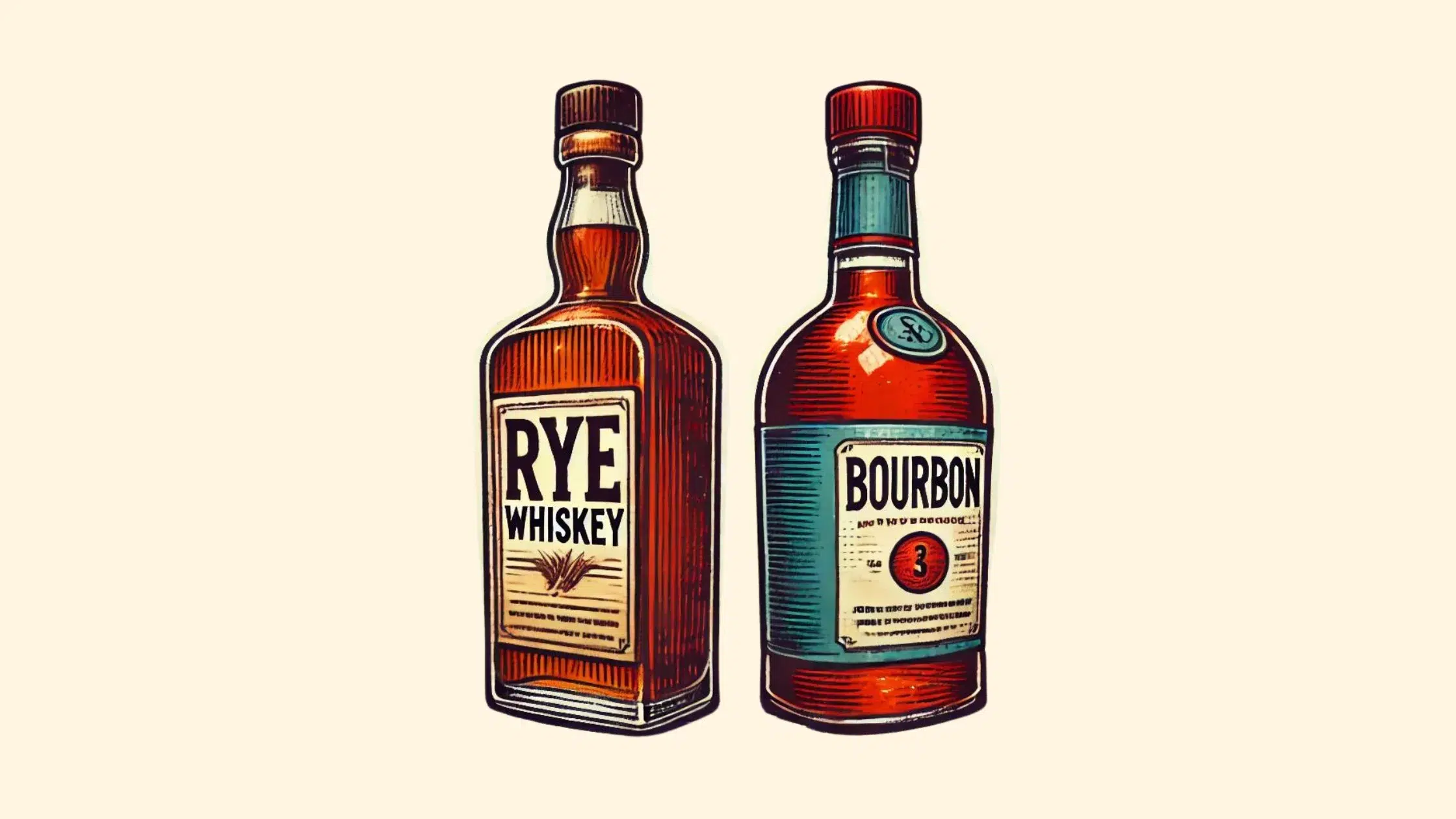Navigating the spirited world of whiskey, one often encounters the age-old debate: Bourbon or Rye? These two giants of American whiskey each boast unique characteristics, flavors, and histories that cater to diverse palates and preferences. Bourbon, with its sweet, rich vanilla and caramel notes, offers a smooth sipping experience.
It’s the drink of choice for those who appreciate a whiskey that complements both a quiet evening by the fire and a lively bar scene. On the flip side, Rye Whiskey stands out with its bold, spicy kick, appealing to those who crave a whiskey with a bit more edge. Whether you’re crafting a classic cocktail or exploring the nuances of whiskey neat, the choice between Bourbon and Rye Whiskey invites you to delve deeper into the art of whiskey tasting and mixology.
This exploration not only reveals the distinct flavors and traditions of each but also uncovers your personal taste preferences, guiding you to your perfect whiskey match.
What is Bourbon?
Bourbon is a distinct type of American whiskey that has captivated the palates of spirit enthusiasts around the globe. At its core, bourbon is primarily made from corn, with the grain mash being at least 51% corn, which imparts a characteristic sweetness to the drink. This whiskey must be produced in the United States, adhering to strict regulations that define its production process and aging.
Bourbon is aged in new, charred oak barrels, a requirement that contributes to its unique flavor profile, including notes of vanilla, oak, and caramel. The creation of bourbon is a meticulous process that involves controlled distillation and aging periods, ensuring that each bottle meets the high standards set by U.S. law.
These regulations also stipulate that bourbon must be distilled to no more than 160 proof (80% alcohol by volume) and entered into the barrel for aging at no more than 125 proof (62.5% ABV). Furthermore, bourbon cannot contain any added flavoring, coloring, or other additives, ensuring that its taste is derived purely from the raw ingredients and the aging process. Bourbon’s history is deeply intertwined with American culture, tracing back to the 18th century.
It is widely believed that bourbon takes its name from Bourbon County, Kentucky, a region that played a pivotal role in the development and popularization of the whiskey. Today, Kentucky remains synonymous with bourbon production, though the spirit is produced in several states across the country. The appeal of bourbon lies not only in its rich, complex flavor but also in its versatility.
It can be enjoyed neat, on the rocks, or as a base for a wide array of cocktails, making it a favorite among both connoisseurs and casual drinkers. The bourbon industry has seen a resurgence in popularity in recent years, with an increasing number of distilleries and a growing interest in artisan and craft productions. In summary, bourbon is a uniquely American whiskey known for its sweet, robust flavor and strict production standards.
Its deep roots in American history and culture, combined with its versatility in consumption, make bourbon a cherished spirit worldwide.
What is Rye Whiskey?
Rye Whiskey is an American whiskey characterized by its bold, spicy flavor, derived from its primary ingredient, rye grain. To be classified as rye whiskey in the United States, the mash must contain at least 51% rye, which imparts a distinctively spicy and fruity taste profile. This type of whiskey shares some production similarities with bourbon but stands out due to its sharper flavor notes, including pepper, grass, and fruit.
Like bourbon, rye whiskey must be aged in new, charred oak barrels, which contribute to its rich color and complex flavor. However, rye whiskey can be distilled to a higher proof than bourbon, allowing for a broader range of flavor profiles and intensities. The aging process for rye whiskey varies, with no minimum aging period for a standard rye whiskey, but to be labeled as a straight rye whiskey, it must be aged for at least two years.
The history of rye whiskey in the United States is nearly as old as that of bourbon, with its roots tracing back to the early settlers of the East Coast, particularly in states like Pennsylvania and Maryland. Today, rye whiskey has experienced a resurgence in popularity, appreciated for its robust flavor that adds depth to cocktails and its enjoyable complexity when sipped neat or on the rocks. In essence, rye whiskey offers a spicier, more robust alternative to the sweeter profile of bourbon, catering to those who appreciate a whiskey with a bold, assertive character.
Its versatility in cocktails and its rich historical roots make it a staple in the American whiskey landscape.
How do their ingredients differ?
The primary distinction between Bourbon and Rye Whiskey lies in their grain compositions. Bourbon’s mash must consist of at least 51% corn, lending it a sweeter flavor profile with notes of vanilla and caramel. On the other hand, Rye Whiskey requires a mash of at least 51% rye grain, giving it a spicier and more robust taste, characterized by pepper and fruit notes.
These core ingredients are the backbone of each whiskey’s unique flavor and identity, directly influencing their distinct taste experiences.
Bourbon’s grain mixture must be at least 51% corn
Bourbon, a signature American whiskey, is distinguished by its grain bill, which mandates a minimum of 51% corn. This high corn content is responsible for bourbon’s inherent sweetness, offering flavors of vanilla and caramel that are cherished by whiskey enthusiasts.
Rye Whiskey’s grain mixture must be at least 51% rye
In contrast, Rye Whiskey sets itself apart with a grain bill requiring at least 51% rye. This composition imbues rye whiskey with its characteristic spicy and bold taste, marked by notes of pepper and fruit, appealing to those who favor a whiskey with a more assertive profile.
How does the distillation process vary between them?
The distillation process between Bourbon and Rye Whiskey differs primarily in the maximum proof at which they are distilled. Bourbon is distilled at no more than 160 proof (80% alcohol by volume), ensuring a retention of its sweet flavor profile derived from the high corn content. Conversely, Rye Whiskey can be distilled at a higher proof, allowing for a broader spectrum of flavor development that emphasizes its spicy and robust character.
This distinction in distillation proof contributes significantly to the contrasting taste profiles of Bourbon and Rye Whiskey.
Bourbon is distilled at no more than 160 proof
Bourbon undergoes distillation at a cap of 160 proof (80% alcohol by volume), a process that preserves its sweet nuances, largely attributed to its corn-rich mash.
Rye Whiskey can be distilled at a higher proof
In contrast, Rye Whiskey has the flexibility to be distilled at a higher proof, enabling a wider range of flavor concentration that accentuates its inherently spicy and bold characteristics.
What are the flavor profiles of each?
Bourbon boasts a sweeter flavor profile, enriched with notes of vanilla and caramel, thanks to its primary composition of corn. This sweetness is often accompanied by hints of oak and fruit, resulting from its aging process in new, charred oak barrels. Rye Whiskey, distinguished by its minimum 51% rye grain composition, offers a spicier flavor profile.
It is known for its bold pepper and fruit notes, with some variations also presenting undertones of grass or herbs. The spiciness of rye whiskey provides a stark contrast to the smooth sweetness of bourbon, catering to a diverse palate of whiskey enthusiasts.
Bourbon’s flavor profile is sweeter, with vanilla and caramel notes
Bourbon is renowned for its sweeter essence, primarily due to its corn base. This sweetness is accentuated by rich layers of vanilla and caramel, creating a smooth and inviting taste profile.
Rye Whiskey’s flavor profile is spicier, with pepper and fruit notes
Contrastingly, Rye Whiskey stands out with a spicier kick, a direct reflection of its rye grain predominance. This spice is complemented by vibrant pepper and fruit notes, offering a bold and complex flavor journey.
How does aging affect their tastes?
Aging plays a crucial role in the development of flavor profiles for both Bourbon and Rye Whiskey. For Bourbon, the aging process in new, charred oak barrels enhances its sweetness, allowing the whiskey to develop deeper vanilla and caramel notes over time. This maturation also introduces layers of complexity, adding to the richness of the bourbon’s flavor.
In contrast, Rye Whiskey’s aging process accentuates its spicy characteristics. The longer it ages, the more its pepper and fruit notes evolve, gaining complexity and depth. The interaction with the oak barrels also introduces a subtle smoothness, balancing the inherent spiciness of the rye, and sometimes adding hints of wood and smoke to the profile.
Thus, aging not only mellows the whiskey but significantly influences the taste, bringing out the unique characteristics of each type.
Bourbon develops a richer sweetness over time
As Bourbon ages, its inherent sweetness is amplified, leading to a richer tapestry of vanilla and caramel flavors. This maturation process enhances its smoothness and depth, making each sip a more indulgent experience.
Rye Whiskey’s spicy flavors become more complex
Rye Whiskey, with time, sees its bold, spicy flavors evolve into a more intricate blend. The aging process adds layers of complexity to its pepper and fruit notes, enriching the whiskey’s character and delivering a more nuanced taste profile.
What are the legal requirements for Bourbon and Rye Whiskey in the United States?
In the United States, both Bourbon and Rye Whiskey are subject to specific legal requirements that define their production and categorization. For Bourbon, the law mandates that the grain mixture must be at least 51% corn, and it must be aged in new, charred oak barrels. Additionally, Bourbon must be distilled to no more than 160 proof and entered into the barrel for aging at no more than 125 proof.
Rye Whiskey, similarly, must have a mash bill of at least 51% rye to be labeled as such. It also shares the requirement of aging in new, charred oak barrels, though the regulations regarding distillation proof can vary, allowing Rye Whiskey to be distilled at a higher proof than Bourbon. To be labeled as a straight whiskey, both Bourbon and Rye must be aged for a minimum of two years.
These legal stipulations ensure the quality and authenticity of American whiskey, preserving the distinctive characteristics that define Bourbon and Rye Whiskey.
Bourbon’s legal requirements include aging in new, charred oak barrels
Bourbon must be aged in new, charred oak barrels, a rule that significantly influences its flavor profile, imbuing it with distinctive notes of vanilla, caramel, and oak.
Rye Whiskey’s legal requirements are similar but less strict on aging
While Rye Whiskey also requires aging in new, charred oak barrels, the regulations offer more flexibility in terms of the aging process, allowing for a wider variety of flavor developments within the category.
How are they used in cocktails?
Bourbon and Rye Whiskey each bring unique flavors to cocktails, influencing the choice of whiskey based on the desired taste profile. Bourbon, with its sweeter, vanilla, and caramel notes, is often used in cocktails that benefit from a smoother, richer base, such as the Old Fashioned and Mint Julep. These drinks highlight Bourbon’s inherent sweetness and complexity, making it a popular choice for cocktails that require a balanced yet pronounced whiskey flavor.
On the other hand, Rye Whiskey, known for its spicier and more robust profile, is favored in cocktails like the Manhattan and Sazerac. Its bold pepper and fruit notes add depth and intensity to cocktails, offering a sharper contrast to the mixers and other ingredients. Rye’s distinct spice-driven character makes it ideal for those who prefer a cocktail with a bit more bite and complexity.
The selection between Bourbon and Rye Whiskey in cocktails often comes down to personal preference and the specific flavor dynamics of the drink, with each type of whiskey offering a distinct contribution to the world of mixology.
Popular Bourbon cocktails include the Old Fashioned and Mint Julep
Bourbon, celebrated for its sweet profile of vanilla and caramel, is the whiskey of choice for classic cocktails like the Old Fashioned and Mint Julep. These cocktails highlight Bourbon’s richness and depth, making it a favored spirit for these traditional drinks.
Popular Rye Whiskey cocktails include the Manhattan and Sazerac
Rye Whiskey, recognized for its spicier, more robust flavors, is preferred in cocktails such as the Manhattan and Sazerac. The boldness of rye adds a layer of complexity and a sharp edge to these iconic drinks, offering a distinct taste experience.
What are the price ranges for each?
The price range for both Bourbon and Rye Whiskey varies widely, accommodating budgets from the economical to the ultra-premium. Bourbon can be found at entry-level prices for everyday enjoyment, with bottles starting in the lower double digits. However, for enthusiasts seeking rarity and complexity, the cost can escalate into the hundreds or even thousands for a single bottle, reflecting the age, distillation process, and exclusivity.
Similarly, Rye Whiskey follows a parallel pricing structure. Affordable options are readily available, making rye accessible for casual sipping or cocktail mixing. At the high end of the spectrum, rye whiskey can command premium prices, especially for bottles that are limited edition, aged for extended periods, or produced by renowned distilleries.
This broad price range ensures that both Bourbon and Rye Whiskey are accessible to a diverse audience, from those new to whiskey tasting to seasoned collectors seeking exceptional bottles to add to their collection.
Bourbon can range from budget to ultra-premium
Bourbon offers a wide array of pricing, accommodating both the budget-conscious drinker and the aficionado willing to invest in ultra-premium selections. This spectrum allows for a diverse exploration of flavors and ages at various price points.
Rye Whiskey generally follows a similar price range
Rye Whiskey, much like bourbon, spans a similar price range. From accessible, budget-friendly bottles to high-end, collectible editions, rye whiskey caters to a broad audience, ensuring options for every type of whiskey enthusiast.
How should one decide between Bourbon and Rye Whiskey?
Deciding between Bourbon and Rye Whiskey hinges on personal taste preferences and the desired cocktail profile. For those who favor a sweeter, smoother whiskey with notes of vanilla and caramel, Bourbon is the ideal choice. Its rich and full-bodied flavor makes it versatile for sipping neat or as a base in cocktails that complement its sweetness.
Conversely, individuals with a palate for spicier, more robust flavors might prefer Rye Whiskey. Its pronounced pepper and fruit notes, coupled with a certain boldness, make it suitable for cocktails that benefit from a sharper, more pronounced whiskey character. Additionally, the choice between Bourbon and Rye can be influenced by the specific cocktails one enjoys.
Classic cocktails like the Old Fashioned and Mint Julep are traditionally made with Bourbon, whereas the Manhattan and Sazerac are known for using Rye Whiskey. Ultimately, the decision comes down to experimenting with both types of whiskey to discover which flavor profiles and cocktail combinations best suit one’s taste.
Consider flavor preference: sweet vs. spicy
When choosing between Bourbon and Rye Whiskey, consider your flavor preference. If you lean towards a sweeter, more mellow taste with undertones of vanilla and caramel, Bourbon will likely suit your palate. For those who prefer a spicier, more robust profile with notes of pepper and fruit, Rye Whiskey is the better option.
Consider cocktail choice: traditional Bourbon or Rye recipes
Your cocktail preference can also guide your choice. If you enjoy classic cocktails that highlight the smooth, rich flavors of whiskey, such as the Old Fashioned or Mint Julep, Bourbon is an excellent base. Conversely, if you favor drinks with a bit more bite and complexity, such as the Manhattan or Sazerac, Rye Whiskey’s boldness enhances these recipes beautifully.





